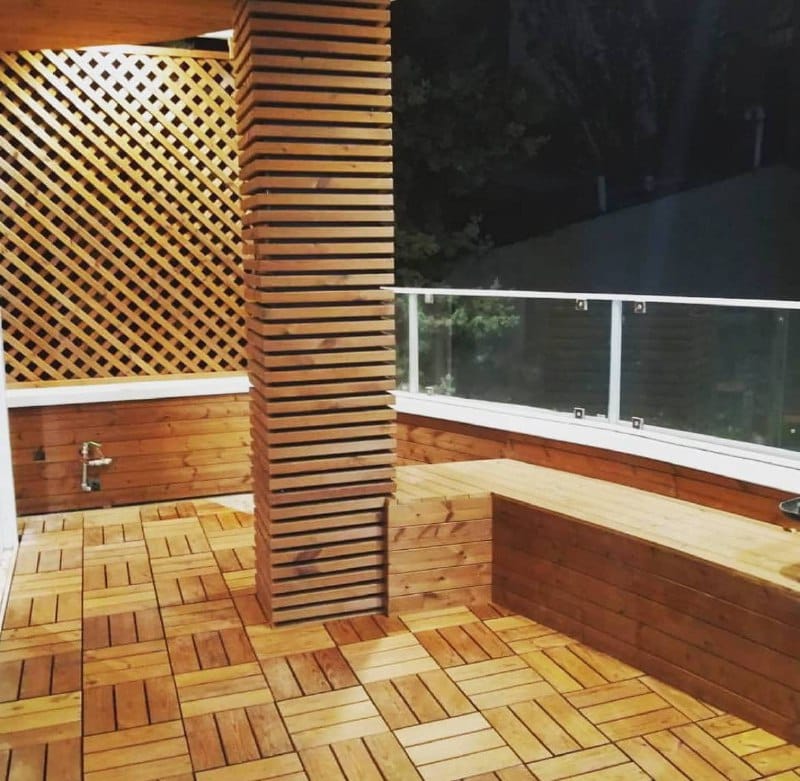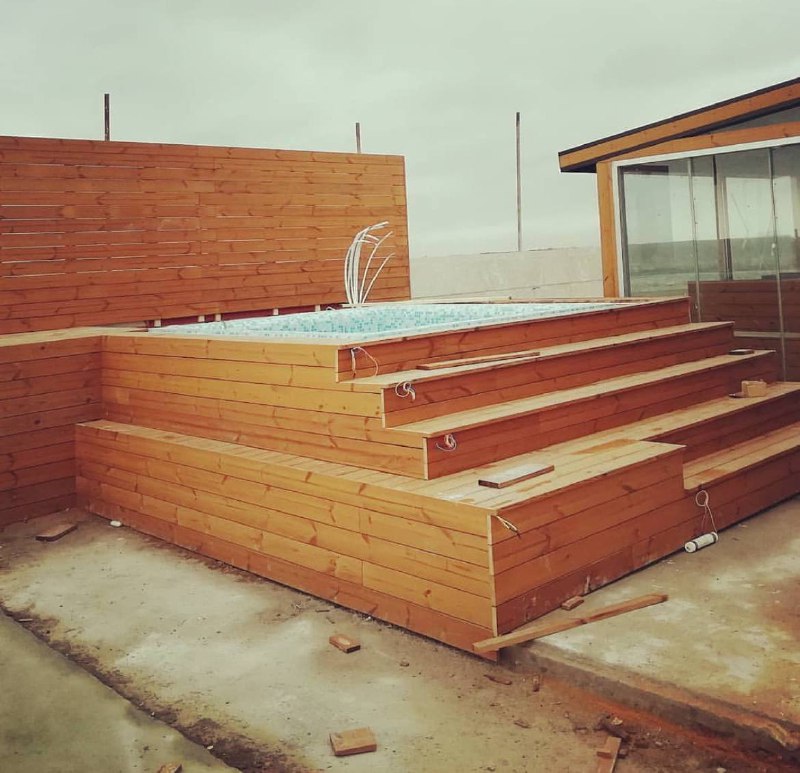
Abstract: The price of Iranian thermal wood of Memerica company, special sale for the new year
price thermowood
The price of thermally modified wood, also known as thermowood price, can vary depending on the type of wood, the size and dimensions of the wood, and the supplier. On average, thermo wood can cost between $3 to $10 per linear foot for decking materials and between $5 to $15 per square foot for cladding or siding materials. It’s best to contact local suppliers or manufacturers for specific pricing information based on your project requirements

What is the use of thermo wood?
Thermo wood, also known as thermally modified wood, has several uses due to its enhanced properties resulting from the thermal modification process. Some common uses of thermo wood include
Decking: Thermo wood is often used for outdoor decking due to its increased resistance to decay, rot, and insects. It has a reduced moisture content, making it more stable and less prone to warping or cracking
Cladding/Siding: Thermo wood is used for exterior cladding or siding on buildings due to its improved durability and stability. It can provide a natural and aesthetic appearance while offering protection against the elements
Flooring: Thermo wood can be used for interior flooring applications as it is more resistant to moisture and wear compared to untreated wood. It can provide a warm and natural look to indoor spaces
Furniture: Thermo wood is also used in furniture manufacturing due to its enhanced strength, stability, and resistance to decay. It can be shaped and finished to create durable and attractive furniture pieces
Outdoor Structures: Thermo wood is suitable for various outdoor structures such as pergolas, fences, and gazebos due to its durability and resistance to weathering
Overall, thermo wood is a versatile material that can be used in a wide range of applications where enhanced durability, stability, and resistance to decay are desired
How is thermo wood produced?
Thermo wood is produced through a thermal modification process that involves subjecting the wood to high temperatures in a controlled environment. The process typically consists of the following steps
Drying: The wood is first dried to reduce its moisture content. This initial drying step helps prepare the wood for the subsequent thermal modification process
Heat Treatment: The dried wood is then placed in a specialized kiln or chamber where it is heated to high temperatures, usually between 180°C to 230°C (356°F to 446°F). The wood is heated in the absence of oxygen or in a low-oxygen environment to prevent combustion
Steaming: Some thermo wood processes involve a steaming phase before or during the heat treatment process. Steaming can help improve the color uniformity of the wood and reduce the risk of surface checking or cracking
Cooling and Conditioning: After the wood has been subjected to the desired temperature and time parameters, it is gradually cooled down to room temperature. The wood is then conditioned to stabilize its moisture content and properties
The thermal modification process alters the chemical and physical properties of the wood, resulting in enhanced characteristics such as improved dimensional stability, increased resistance to decay and insects, and a darker color tone. Thermo wood retains its natural appearance while offering superior durability compared to untreated wood
It’s important to note that the specific parameters of the thermal modification process, such as temperature, duration, and treatment method, can vary depending on the desired properties and end-use applications of the thermo wood

What kind of wood is the best type of wood for heating and increasing durability
When it comes to choosing the best type of wood for heating and increasing durability, hardwoods are generally preferred over softwoods due to their higher density and energy content. Some of the best types of hardwoods for heating and durability include
Oak: Oak is a popular hardwood known for its high energy content and slow-burning properties. It produces long-lasting heat and is prized for its durability
Maple: Maple is another hardwood that burns well and produces a steady heat output. It is also known for its durability and resistance to splitting
Ash: Ash wood is valued for its high energy content and clean-burning characteristics. It burns hot and evenly, making it an excellent choice for heating
Beech: Beech wood is a dense hardwood that burns well and provides a long-lasting heat source. It is also known for its durability and strength
Birch: Birch wood is a hardwood that burns quickly and produces a high heat output. It is ideal for starting fires or boosting the heat in a wood stove
Hickory: Hickory is a dense hardwood that burns hot and produces a long-lasting heat source. It is also prized for its durability and resistance to decay
It’s important to ensure that the wood you use for heating is properly seasoned and has a low moisture content to maximize its efficiency and reduce the risk of creosote buildup in chimneys. Additionally, choosing hardwoods with high energy content and low resin content can help improve the overall performance of the wood as a heating fuel
Tell me a complete article about the advantages and disadvantages of thermo wood
Thermo wood, also known as heat-treated wood, is a type of modified wood that has undergone a thermal modification process to enhance its properties. This process involves heating the wood to high temperatures in a controlled environment, which results in improved durability, stability, and resistance to decay. Thermo wood is becoming increasingly popular in various applications due to its unique characteristics. In this article, we will discuss the advantages and disadvantages of thermo wood

Advantages of Thermo Wood
Enhanced Durability: Thermo wood undergoes a thermal modification process that significantly increases its resistance to rot, decay, and insect infestations. This makes thermo wood an excellent choice for outdoor applications such as decking, cladding, and fencing
Improved Stability: Thermo wood has reduced moisture absorption and swelling properties compared to untreated wood. This enhanced stability makes thermo wood less prone to warping, cracking, and shrinking, resulting in a longer lifespan and reduced maintenance requirements
Enhanced Aesthetics: Thermo wood has a rich, dark color and a uniform appearance that can enhance the visual appeal of any project. The thermal modification process also enhances the natural grain patterns of the wood, creating a unique and attractive finish
Eco-Friendly: The thermal modification process used to produce thermo wood is environmentally friendly, as it does not involve the use of chemicals or additives. Additionally, thermo wood is sourced from sustainably managed forests, making it a more sustainable choice compared to other building materials
Dimensional Stability: Thermo wood has improved dimensional stability, meaning it is less likely to warp or twist when exposed to changes in temperature and humidity. This makes thermo wood an ideal choice for applications where stability is crucial, such as flooring and furniture
Disadvantages of Thermo Wood
Cost: Thermo wood is generally more expensive than untreated wood due to the additional processing required during the thermal modification process. The higher cost of thermo wood may be a deterrent for some budget-conscious consumers
Limited Availability: Thermo wood may not be as readily available as traditional wood species, depending on your location. This limited availability could pose challenges in sourcing thermo wood for certain projects
Reduced Workability: The thermal modification process can affect the workability of thermo wood, making it harder to cut, sand, and shape compared to untreated wood. This reduced workability may require specialized tools and techniques for processing thermo wood
Limited Color Options: Thermo wood typically has a darker color compared to untreated wood, which may limit the color options available for certain projects. If you prefer lighter or more vibrant colors, thermo wood may not be the best choice for your needs
In conclusion, thermo wood offers several advantages such as enhanced durability, stability, and aesthetics, making it a popular choice for various applications. However, it also has some disadvantages including higher cost, limited availability, reduced workability, and limited color options. It’s essential to weigh these pros and cons carefully to determine if thermo wood is the right choice for your specific project requirements
What are the characteristics of thermowood?
Thermo wood, also known as heat-treated wood, possesses several unique characteristics that make it a popular choice for various applications. Here are some of the key characteristics of thermo wood
Enhanced Durability: Thermo wood undergoes a thermal modification process that significantly increases its resistance to rot, decay, and insect infestations. This enhanced durability makes thermo wood suitable for outdoor applications where exposure to moisture and environmental elements is a concern
Improved Stability: Thermo wood has reduced moisture absorption and swelling properties compared to untreated wood. This enhanced stability minimizes the risk of warping, cracking, and shrinking, making thermo wood a more reliable and long-lasting material
Resistance to Decay: The thermal modification process used to produce thermo wood alters the chemical composition of the wood, making it more resistant to decay-causing organisms such as fungi and bacteria. This resistance to decay ensures that thermo wood maintains its structural integrity over time
Dimensional Stability: Thermo wood exhibits improved dimensional stability, meaning it is less prone to changes in size and shape when exposed to fluctuations in temperature and humidity. This dimensional stability makes thermo wood an ideal choice for applications where precision and consistency are essential
Aesthetic Appeal: Thermo wood has a rich, dark color and a uniform appearance that enhances its visual appeal. The thermal modification process also enhances the natural grain patterns of the wood, creating a distinctive and attractive finish that adds character to any project
Eco-Friendly: The thermal modification process used to produce thermo wood is environmentally friendly, as it does not involve the use of chemicals or additives. Additionally, thermo wood is sourced from sustainably managed forests, making it a more sustainable choice compared to other building materials
Low Maintenance Requirements: Due to its enhanced durability and resistance to decay, thermo wood requires minimal maintenance compared to untreated wood. This can result in cost savings and reduced upkeep over the lifespan of the material
Overall, thermo wood offers a combination of durability, stability, resistance to decay, aesthetic appeal, and eco-friendliness that makes it a versatile and desirable material for a wide range of applications. Its unique characteristics make thermo wood a popular choice for outdoor projects, decking, cladding, furniture, and other applications where performance and aesthetics are important
